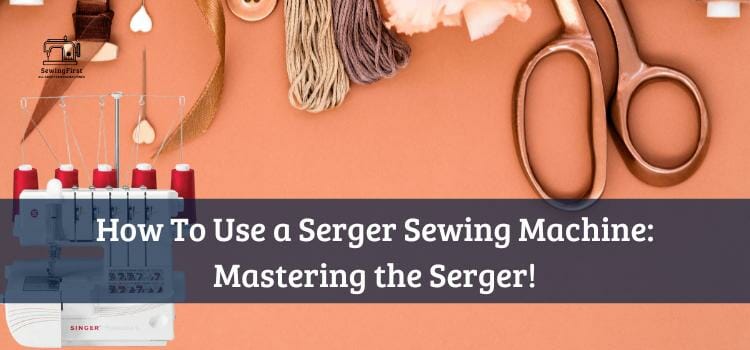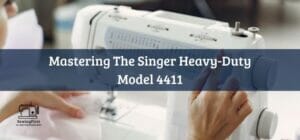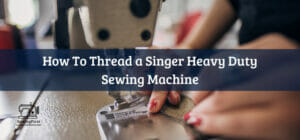The Serger sewing machine is the ultimate tool for crafting freedom. Its versatility and power allow us to create garments that are unique and tailored just for us – a way of self-expression with thread and fabric.
No longer do we have to settle for off-the-rack clothes or struggle with traditional machines. With the right knowledge and skill, this powerful machine can help you turn pieces of cloth into works of art.
For those who may feel intimidated by the prospect of learning how to use a Serger sewing machine, fear not! This article will provide an introduction to how to get started in mastering its many complexities.
We’ll discuss what types of fabrics work best with these machines, which accessories you need, and tips for troubleshooting common problems. By the end of this guide, you’ll know enough about using a Serger sewing machine to make any project your heart desires.
Are you ready? Let’s begin our journey into the wonderful world of creating beautiful garments with a Serger sewing machine!
Related Topic: How to Take Care of Your Sewing Machine? That Nobody Tells You!
Table of Contents
ToggleWhat is a Serger Sewing Machine?
The art of sewing has come a long way since its inception – and the Serger sewing machine is one prime example. Also known as an overlock stitch, it does more than just sew fabric together; it finishes raw edges with a professional touch. It helps reduce bulkiness in seams and produces a perfectly even chain stitch that looks like no other!
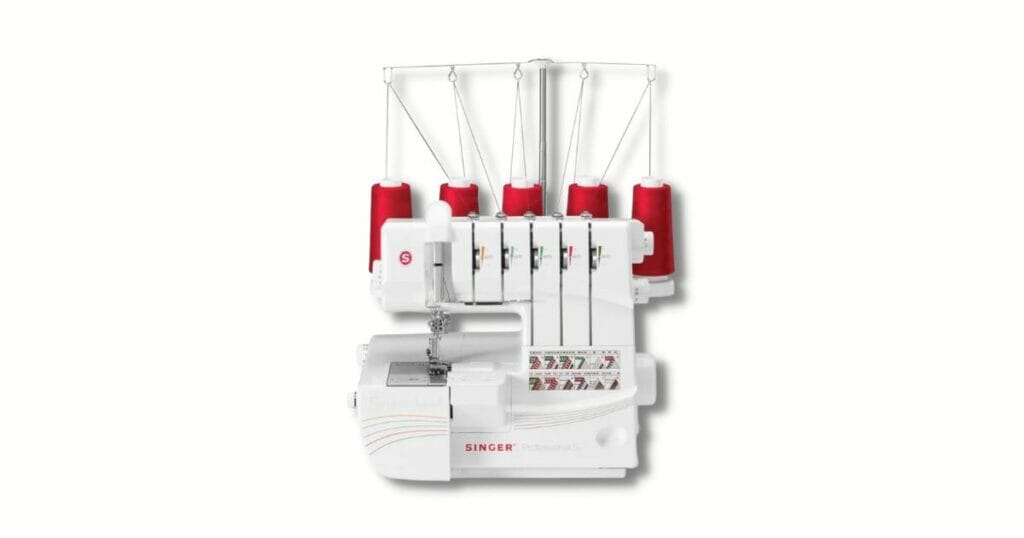
But what exactly is this versatile machine? A Serger consists of four or five threads (depending on your model) that are looped through several looper threads guides around the cutting blade. This creates a secure seam with cleanly finished edges without any extra effort from you.
Plus, you can adjust the tension of each thread to get whatever effect you want for your project. No matter if you’re making clothes, accessories, linens, or anything else, having a reliable serger will make all the difference!
What Can A Serger Do?
A Serger sewing machine, also known as an overlock Serger, is a specialized tool that can make a wide variety of stitches. It’s designed to quickly and easily join fabrics together with neat seams and professional-looking hems. With it, you can create beautiful garments for yourself or others.
Serger uses threads in the upper and lower loopers along with an overlock foot which creates multiple thread loops around the edge of two pieces of fabric. This process produces a secure seam that won’t unravel, even when stretched.
Sergers are capable of making several different types of stitches – from zigzag stitching to mock cover stitching – all while finishing off edges with their own unique stitch patterns. In addition, they’re great for creating ruffles, decorative edgings, elastic casings, and more!
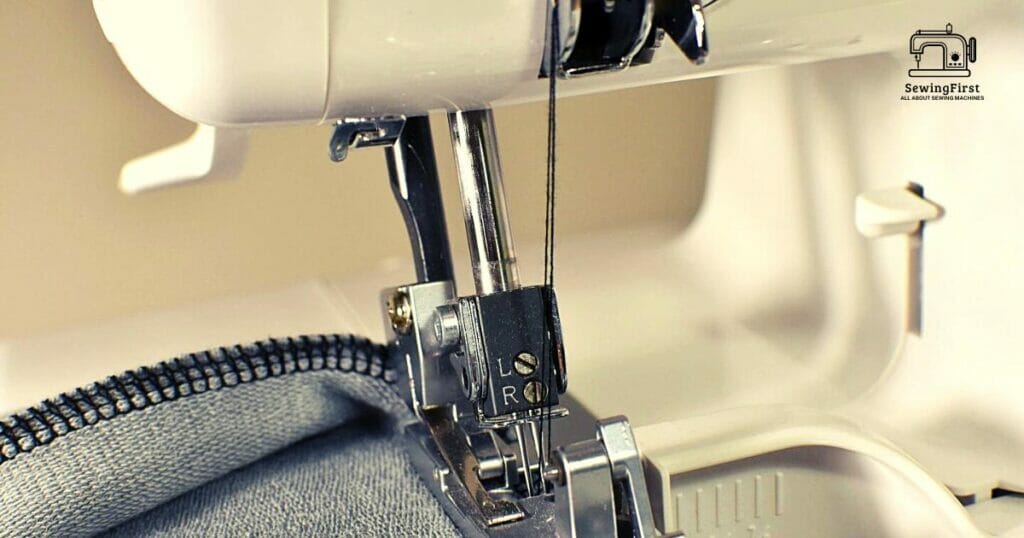
With so many features available on today’s overlock machines, it’s easy to see why sewists have come to love them! Not only do they help save time by replacing tedious hand-sewing tasks but their versatility makes them invaluable tools for any serious sewer looking to take their projects up a notch.
And since most models come equipped with adjustable thread tensions and automatic needle threading capabilities, setting up your serger is easier than ever before – no matter what type of stitch you need!
What is A Serger vs an Overlock Machine?
A serger is like a specialty sewing machine, with the ability to sew and cut the fabric at the same time. It’s an incredibly useful tool that can help sewers of any level take their projects up a notch. The difference between a serger and an overlock machine lies in their presser feet, types of stitches, seam allowances, differential feed dials, and even more specialized features.
To break it down further, both machines use multiple threads to finish seams neatly while trimming away excess fabric. However, this is where they start to differ. A serger offers much more control when it comes to differentiating thread tensions or stitch lengths as well as allowing you to adjust seam widths for varying fabrics or designs.
You also have access to several unique presser feet options on most models such as cording foot attachments and piping applications which are great for adding decorative elements easily by using extra threads from the looper system. Meanwhile, an overlock machine often has fewer settings than its counterpart; making it better suited for basic hems and finishes without having all the bells and whistles of a serger.
From hobbyists creating garments for themselves or others to professional designers looking for complex trim solutions-sergers provide creative freedom through their customizable options. With all these added benefits available at your fingertips there’s no wonder why so many people choose them over other traditional sewing machines!
Why and How to Use A Serger Sewing Machine?
The serger, much like a sewing machine, is the tool of choice for many who love to express their creativity with fabric. Its stitching capabilities are as varied and unique as the fabrics it works on. From seaming edges together seamlessly, to create decorative stitches that bring life to even the most stretchy of fabrics – its possibilities are limitless.
For those looking for a reliable machine from reputable brands such as Brother or Janome, a serger can offer all types of sewing including blind hems, rolled hems, and more. With so many options available for any type of sewing machine enthusiast, a serger could be just what you need to master your craft and open up endless creative opportunities.
Packed with features and benefits designed specifically for sewers, this powerful tool allows users to take their projects to new heights while still maintaining an enjoyable experience.
A serger has something special in store for everyone who wants to get started in the world of fabric crafting – and beyond!
What is Different About a Serger Sewing Machine?
While many people are familiar with traditional sewing machines, a serger machine can provide an entirely different experience. It can be intimidating to try something new like this – but if you’re looking for the perfect seams and edges on lightweight fabrics, then a serger is definitely worth exploring! Here’s what it brings to your sewing projects:
Spools of Thread
A serger uses up to four separate spools of thread at once so that you can create more intricate patterns and shapes than with a regular sewing machine.
Seam Edges
Sergers also give fabric edges much smoother results than a sewing machine because they use overlock stitches instead of straight ones. This means you won’t have any loose threads or frayed fabric when working with delicate materials.
Variety of Fabrics
You can work with lightweight fabrics such as chiffon or silk without worrying about them getting damaged during stitching since the loops created by overlocks help keep everything in place. Plus, you don’t need to worry about using a scrap of fabric as interfacing since the loops will hold all layers together.
Serging provides amazing opportunities to add beautiful finishes to your projects while saving time and effort, making it an invaluable tool for sewers who want professional-looking results quickly and easily.
So why not give it a try? With just a few practices runs on some test pieces of fabric, you’ll soon see why everyone loves their serger!
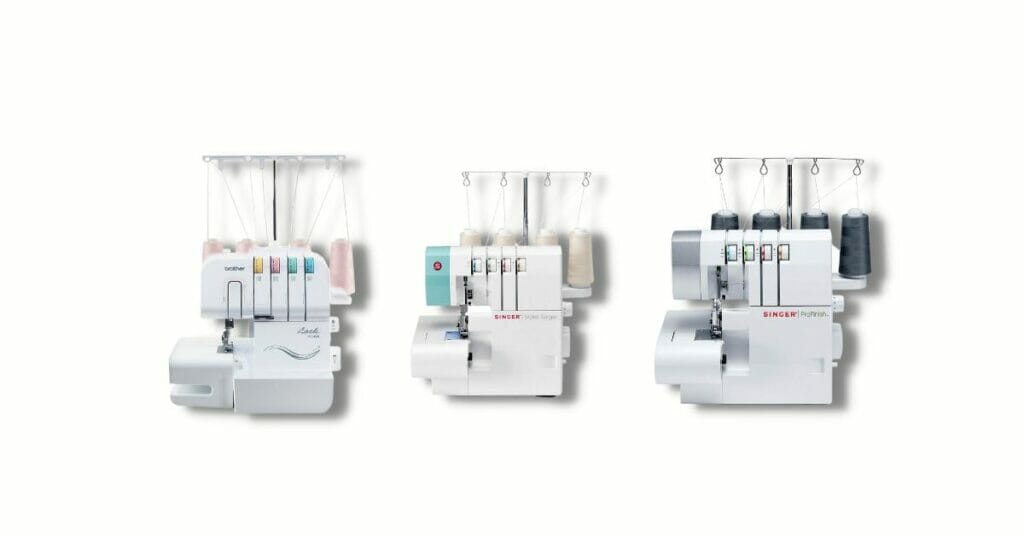
What Can’t a Serger do?
Are you wondering what a serger sewing machine can and cannot do? This type of sewing machine is different than the standard one, but it still serves its purpose. From fabric edges to straight stitches, there are certain limitations that come with this type of machine. Let’s explore further into what tasks a serger is capable and not so capable of handling.
A major benefit of using a serger over a standard sewing machine is that it helps clean up excess fabric from seams. It does this by cutting away any unwanted material around the edge when stitching two pieces together as well as finishing off the raw edge for a professional look.
However, unlike regular machines, sergers cannot produce intricate embroidery designs or use decorative threads due to their limited number of thread spindles. Additionally, they cannot make buttonholes like most standard machines because they only work on linear patterns rather than circles or ovals.
So while these machines have some restrictions compared to traditional models, they are great tools if you need something quick and easy to sew fabrics together without dealing with the hassle of fraying edges or bulkiness in your finished product.
How To Buy A Serger?
Did you know that the average person spends over $1,000 on a sewing machine? If you’re looking for an upgrade from your regular sewing machine and want to take advantage of serger stitching, then it’s important to understand how to buy a serger.
A serger is designed to provide professional-grade stitch widths along the edges of the fabric. It also has the capability of using several spools of thread at once while creating stitches much faster than a regular sewing machine. When shopping around for the perfect serger sewing machine, there are a few key features to consider before making any purchase decision.
First and foremost, look closely at the number of threads supported by each model as well as what type (e.g., straight/overlock) and size (large/small) stitches they can create.
Additionally, pay attention to whether or not additional attachments such as piping foot or cover stitch feet come with the product – these can be invaluable when working with more complex fabrics like knits or leather!
Finally, don’t forget about budgeting; it’s important to compare prices from various retailers in order to make sure you get a good deal without compromising quality.
Buying a new serger can seem overwhelming but armed with some research and understanding about what makes one better than another, you’ll be set up for success! With this knowledge in hand, you’ll have all the tools needed to choose an ideal device that meets both your crafting goals and budget needs.
Serger Uses Several Spools Of Thread At Once
A serger is a unique machine, capable of creating intricate stitching with ease. Its secret lies in its ability to utilize multiple spools of thread at the same time. Picture this: several vibrant threads intertwining and weaving together to create beautiful fabrics for any number of sewing projects. It’s almost magical!
This capability is what makes it so efficient when compared to traditional machines that use only one spool. Whereas single-spool machines require constant changing out of bobbins, the serger eliminates this extra step, allowing you more freedom and less interruption while crafting your masterpiece. As such, this multi-thread feature adds a level of complexity and finesse to every project – something no bobbin can ever provide.
Sergers Don’t Use Bobbins
The world of serging is a wild and untamed one. It’s like the Wild West, where you don’t need to worry about bobbins – it’s all spools here! Just when we thought sewing machines couldn’t get any more complicated, along came the invention of sergers. These clever contraptions just keep getting better and better at what they do.
No longer are we limited by the tedious bobbin-threading process; now, with the use of two or three needles and several spools of thread at once, our creative possibilities have been exponentially expanded.
We can craft garments faster than ever before without sacrificing quality for speed. And this isn’t even mentioning that professional look that only a serger can give us! In short, if you’re looking for advanced garment construction techniques in your sewing projects, then a serger machine should be on your list of must-haves.
Sergers Can Use 2 Or 3 Needles At Once
Sergers are powerful machines that can be used for a wide range of tasks. From hemming jeans to creating intricate designs, sergers have the capability to do it all! But one feature that really sets these machines apart from standard sewing machines is their ability to use multiple needles at once.
Using two or three needles simultaneously makes binding seams and finishing edges easier than ever before – something no single-needle machine could dream of doing!
This also helps you save time by quickly completing projects in a fraction of the time it would take with regular sewing techniques. Plus, there’s less risk of having thread bunching and puckering along your stitches as well.
So if you’re looking to finish up garment pieces faster while achieving professional-level results, investing in a serger may be just what you need!
Sergers Have Knives To Cut Seam Allowances
A serger is like a samurai sword – efficient, agile, and precise. It can slice through fabrics with ease and accuracy. That’s because it comes equipped with sharp knives that cut seam allowances quickly and cleanly. Sergers make sewing projects faster by using two or three needles at once to sew overlapping seams while their blades trim away excess fabric in one pass.
This helps save time as well as create professional-looking edges on finished garments. The knife blade also helps prevent the fraying of delicate materials such as chiffon or lace, which would otherwise be tedious to do manually with scissors.
Additionally, the adjustable width of the cutting blade allows for different types of finishing techniques, including rolled hems, lettuce edging, and flatlock stitching. The speed of a serger varies depending on the type of machine being used but generally ranges from 1000 stitches per minute up to 5000 spm for more advanced models.
However, regardless of its speed rating, having an experienced operator will always result in better results when working with a serger machine!
What is a Serger’s Sewing Speed?
You may be wondering why a serger’s sewing speed should matter to you. But the truth is, it can have an impact on the quality of your finished product. A faster needle speed means fewer skipped stitches and less fabric puckering. Plus, it opens up more possibilities for creative stitching. So let’s take a closer look at what this all means for you as a sewer.
The average serger machine has three different speeds: slow (3,000-4,000 stitches per minute), medium (5,000-7,000 spm), and fast (8,000-12,000 spm). Here are some advantages that come with each one:
- Slow Speed – More control when working with delicate fabrics like silk or chiffon
- Medium Speed – Great for finishing seams on thicker materials like denim or tweed
- Fast Speed – Perfect for high-volume projects like curtains or bags
Knowing which speed works best in any given situation will help you get the most out of your tools and create beautiful pieces of clothing quickly and efficiently.
With that said, here are a few tips to keep in mind while using a serger machine: practice makes perfect
- always use sharp blades
- read the instructions carefully before starting any project
By following these simple steps, you’ll soon become a pro at operating your new device!
Is It Hard To Use A Serger Machine?
Using a serger machine is not as hard as it might seem. In fact, a survey showed that of those who have used one, 98% reported being able to produce satisfactory results with ease. Here are five reasons why:
- It has an intuitive design – the features and settings are easy to understand.
- The instructions are straightforward and clear.
- There is no need for special tools or expertise; anyone can learn how to use it quickly.
- You don’t have to worry about making mistakes; most machines come with reverse stitching capabilities that allow you to fix any errors easily.
- Sergers provide excellent control over the finished product, allowing you to customize your project in ways traditional sewing machines cannot match.
In addition, serger machines offer a wide range of stitch options, so you can choose what works best for your purpose without having to invest in multiple separate pieces of equipment. And because they’re relatively affordable compared to regular sewing machines, using a serger doesn’t require breaking the bank either!
All these factors make serging quick and convenient for all kinds of projects – from home decoration items like curtains and pillows to more complex creations such as garments or quilts. With a little practice and patience, anyone can become an expert at handling a serger machine in no time. Moving on from this topic, let’s take a look at the cost of owning one.
Serger Price
An essential part of the serger machine’s appeal is its cost. Not everyone can afford a high-end sewing machine, but with a serger, you get professional quality at an affordable price.
For example, I recently purchased my own mini serger for just $150! The fact that this small investment allowed me to create the same kind of stitching as much more expensive machines blew me away.
But affordability isn’t the only factor to consider when investing in a serger. It’s important to research what features are necessary for your projects and then look for a model within your budget that offers those functions.
If you want advanced features like automatic threading or adjustable stitch widths, it may be worth spending some extra money on a higher-end model. Otherwise, there are plenty of basic models available that will do the job without breaking the bank.
So whether you’re looking for something simple or something more complex, understanding the basics of how much to expect from each type of serger can help ensure you find the best option for your needs and budget.
Must-Have Serger Functions
Sergers are a great tool for sewing, and they come with features that make them even better. One of the best things about serger machines is their ability to help you craft pieces quickly and efficiently. To get the most out of your machine, though, it’s important to know what functions are must-haves when making a purchase.
When I bought my first serger, I remember being overwhelmed by all the different options available. But after doing some research, I realized there were certain features that would be essential for me to have in order to do quality work on my projects.
These included adjustable stitch length, differential feed control, multiple thread tension settings, and an automatic thread cutter. Having these capabilities allowed me to create custom stitches and hems effortlessly – something that was impossible with a regular sewing machine.
The right selection of serger accessories can also bring plenty of benefits – from creating rolled hems or adding decorative stitching patterns to giving fabrics a professional finish. There are so many possibilities when using one of these machines!
So if you’re looking into purchasing a new serger machine, considering which features will suit your needs best will ensure you get maximum value for money and top-notch results every time.
Conclusion
In conclusion, a serger sewing machine is a great investment for anyone looking to take their sewing projects to the next level. This powerful tool can help you create professional-looking garments and accessories with ease.
With its ability to quickly sew seams and edges, as well as add decorative trims, it’s no wonder why more and more people are turning to this versatile machine.
We highly recommend researching what functions you need before purchasing a serger so that you get one that fits your needs perfectly. Prices will vary depending on how many features or bells and whistles you desire, but even the most basic model can give an incredible finish – like icing on the cake!
FAQs
What can you do with a serger sewing machine?
A serger sewing machine is designed to sew seams, overcast raw edges, and create professional-looking finishes on all types of fabric. It can be used for a variety of tasks such as creating rolled hems, adding decorative stitches, flatlock, and creating a clean edge on lightweight fabrics. Serger sewing machines can also be used to create ruffles, pleats, and other decorative details.
Can a beginner use a serger?
Yes, a beginner can use a serger, but it is important that they learn how to use it properly first. There are many tutorials and books available that provide instruction on how to use a serger. It is also important for a beginner to practice with their serger to become comfortable with it.
Can I use a serger for regular sewing?
Yes, you can use a serger for regular sewing, however, it is not ideal. A serger is designed for use with knits and overlocking, and it may not be the best choice for more complex projects.
What is the main purpose of a serger?
The main purpose of a serger is to finish off the raw edges of the fabric, to create a professional-looking finish, and to join two pieces of fabric together with a secure and durable stitch. It can also be used to create decorative stitching.

